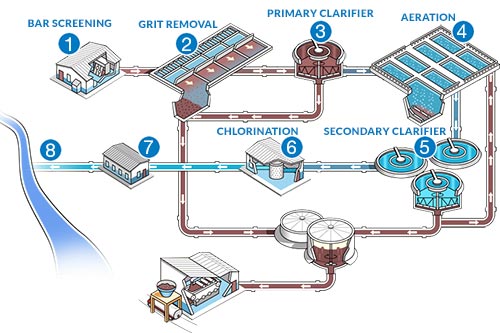The Relation Between Wastewater Management and Public Health
The Relation Between Wastewater Management and Public Health
Blog Article
Understanding Wastewater Therapy Processes and Their Environmental Effect
The complexities of wastewater treatment processes play an essential duty in mitigating environmental challenges connected with water pollution. Each phase, from initial to innovative treatments, is made to resolve details impurities, ultimately safeguarding both public health and wellness and aquatic communities. Despite technological developments in treatment performance, significant difficulties persist, including the monitoring of residual toxins and the implications of nutrient runoff. As we discover the intricacies of these processes, it comes to be important to question how much existing methodologies can progress to meet the expanding needs of sustainability and environmental preservation.
Summary of Wastewater Therapy
How is wastewater transformed into a safe source for the setting? Wastewater treatment is an important procedure made to eliminate contaminants from made use of water, thus guarding public health and wellness and securing environments. This process starts with the collection of wastewater from domestic, industrial, and commercial resources, which is then guided to treatment centers.
At these centers, numerous physical, chemical, and biological techniques are employed to treat the wastewater. Consequently, organic therapies, such as activated sludge procedures, make use of microorganisms to damage down natural issue.
The treated effluent can be safely discharged into all-natural water bodies or recycled for irrigation and commercial functions, promoting resource conservation. Additionally, the therapy procedure produces biosolids, which can be repurposed as fertilizers or soil changes, even more improving sustainability.
Phases of Treatment Procedures
The wastewater treatment process usually includes three primary stages: initial, key, and second therapy. Each phase offers a distinctive function in lowering the pollutant load and guaranteeing the effluent fulfills ecological criteria prior to discharge.

The key treatment stage concentrates on the physical splitting up of put on hold solids from the wastewater. Through sedimentation, much heavier fragments settle at the end of sedimentation tanks, creating sludge, while lighter products, such as oils and greases, float to the surface area and are skimmed. This procedure significantly minimizes the natural and not natural load in the wastewater.
Additional therapy is a biological process aimed at further minimizing the concentration of natural issue. This stage is essential for achieving the necessary biochemical oxygen need (BOD) reduction, eventually leading to cleaner effluent prepared for discharge or additional therapy.

Advanced Therapy Technologies
Adhering to the second treatment processes, progressed therapy modern technologies play a crucial role in further enhancing the quality of dealt with wastewater. These technologies are created to remove residual contaminants that are not properly removed during primary and secondary treatments, making sure the effluent satisfies strict governing criteria.
Among the widely utilized advanced treatment methods are membrane filtration, reverse osmosis, and advanced oxidation processes. Membrane layer filtering, including microfiltration and ultrafiltration, is effective in separating great bits, microorganisms, and see post colloids from the water (Wastewater). Reverse osmosis uses semi-permeable membranes to get rid of view website liquified solids, causing premium water appropriate for different applications
Advanced oxidation procedures (AOPs) utilize solid oxidants to deteriorate natural contaminants, consisting of pharmaceuticals and individual care items that are resistant to traditional therapy. These approaches boost the biodegradability of intricate substances, promoting their removal.
Another significant modern technology is using biological nutrient elimination procedures, which specifically target nitrogen and phosphorus, avoiding eutrophication in getting water bodies. In general, innovative treatment modern technologies are necessary for achieving greater degrees of purification, advertising water reuse, and safeguarding public health while resolving the obstacles associated with wastewater management.
Environmental Benefits of Therapy
Countless environmental advantages emerge from efficient wastewater treatment processes that contribute to ecosystem health and sustainability. Mostly, these processes considerably minimize the release of unsafe contaminants right into all-natural water bodies, which helps keep water communities. By removing contaminants such as heavy steels, nutrients, and microorganisms, dealt with wastewater mitigates the risk of waterborne illness and advertises biodiversity in marine atmospheres.
Furthermore, wastewater therapy facilities commonly utilize advanced technologies that make it possible for water recycling and reuse. This method not only preserves fresh water resources yet additionally minimizes the demand on natural water supplies. Boosted nutrient elimination from wastewater can also stop eutrophication, a process that brings about algal flowers and subsequent oxygen exhaustion in water systems.
Furthermore, reliable treatment processes can lessen greenhouse gas exhausts, especially methane and nitrous oxide, which are usually released throughout without treatment wastewater decay. By catching and making use of biogas from anaerobic digesters, centers can transform waste into renewable resource, therefore adding to a reduction in nonrenewable fuel source dependency.
Difficulties and Future Trends
While the environmental benefits of wastewater treatment are clear, numerous obstacles persist that hinder optimum results in this area. One significant concern is maturing framework, which frequently leads to ineffectiveness and raised operational prices - Wastewater. Lots of treatment plants were designed decades earlier, and their capabilities do not straighten with modern needs, which include more stringent governing standards and higher quantities of wastewater because of urbanization

Looking ahead, there is an expanding emphasis on source recuperation and round economy concepts within wastewater treatment. Technologies such as anaerobic food digestion, which can generate biogas, and advanced filtration modern technologies are acquiring grip. These approaches not just boost treatment performance but likewise advertise sustainability.
Ultimately, dealing with these challenges calls for cooperation among stakeholders, financial investment in modern technology, and a commitment to ongoing study. By welcoming these trends, the wastewater therapy sector can advance to meet the demands of an altering setting and culture.
Verdict
In conclusion, wastewater treatment procedures play an essential duty in improving environmental quality and public health. The multi-stage treatment framework, paired with innovative modern technologies, effectively reduces air pollution and promotes lasting water monitoring.
Report this page